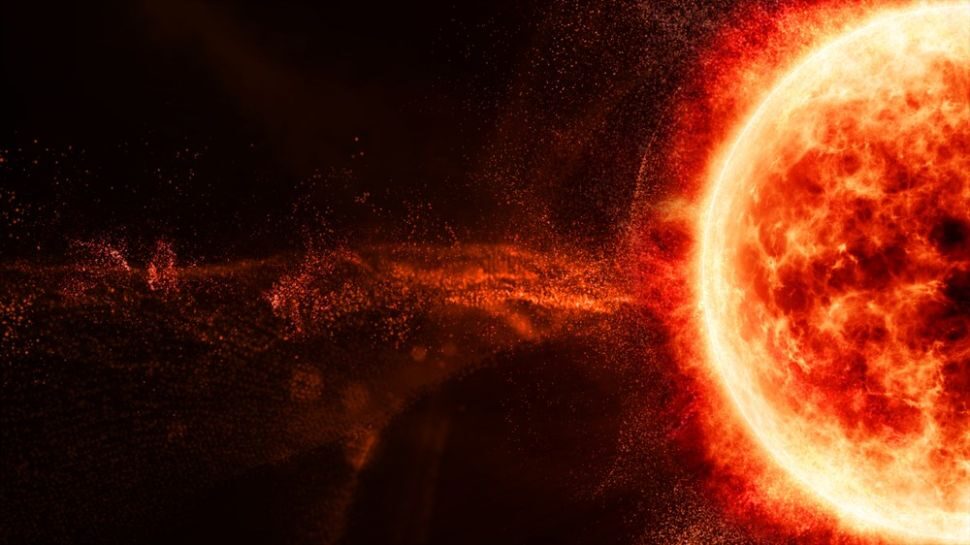
The surprise solar storm hit Earth just before midnight UTC June 25 and continued throughout most of June 26, according to Spaceweather.com. Scientists classified it as a G1-class storm, which means it was strong enough to create weak power grid fluctuations, cause minor impacts to satellite operation, disrupt the navigational abilities of some migrating animals, and cause unusually strong auroras.
The unexpected solar storm coincided with the peak of an extremely rare five-planet alignment, where Mercury, Venus, Mars, Jupiter and Saturn lined up in the sky in order of their proximity to the sun (which hasn't happened since 1864). Amateur astronomers in the northern hemisphere were able to capture images of the surprise auroras as they photobombed the neatly aligned planets.
Photographer Harlan Thomas captured an image of bright auroras in Calgary, Canada, which flashed across the dawn sky in front of the planetary alignment on June 26.
"Wow, talk about surprises," Thomas told Spaceweather.com. "The aurora became [visible to the] naked eye with beautiful pillars," and lasted for around 5 minutes, Thomas said.
Scientists initially suspected coronal mass ejection (CME) caused the freak storm — a large burp of plasma with an embedded magnetic field that is belched out from a sun spot — but they couldn't tell if it had occurred on the Earthside or farside of the sun, according to Spaceweather.com.
However, experts now blame a much rarer co-rotating interaction region (CIR) of the sun; these are "transition zones between slow- and fast-moving streams of solar wind," according to Spaceweather.com. These zones create buildups of plasma that can suddenly unleash shockwaves that are similar to CMEs but don't cause sunspots — which makes them much harder to detect on the sun's surface. The solar wind that blasted Earth on June 25 and 26 peaked at around 1.57 million miles per hour (2.52 million kilometers per hour), which is consistent with other CIRs in the past, according to Spaceweather.com.
The surprise solar storm hit Earth less than a week after a giant sunspot, known as AR3038, doubled in size over a 24-hour period and reached a maximum diameter more than 2.5 times the size of Earth. The giant sunspot sparked fears of a potentially damaging CME hitting our planet, but the spot eventually aimed away from Earth as the sun rotated. Scientists don't know if the gargantuan sunspot and the solar storm are connected.
Auroras occur when charged particles from solar wind slam into oxygen and nitrogen molecules in Earth's upper atmosphere, which ionizes those molecules and causes them to glow. Normally, auroras are confined to regions around the North and South Poles, where Earth's magnetic field, which normally deflects these particles, is weakest. But during solar storms, auroras can become much brighter and can be seen at much lower latitudes than normal. In November 2021, a powerful solar storm produced colorful displays in the United States as far south as Pennsylvania, Iowa and Oregon.
Because scientists initially believed the recent solar storm could have been caused by a farside CME, they predicted that the unusual auroras could last until June 29. However, solar wind activity has now returned to normal.




Reader Comments
Seriously, who tf can tell when they will die? Who tf can tell what tomorrow will bring in the furnace called Sun? The whole delusion of man shows itself in all grandiosity. Scientists that tell You what will happen in 2024, 2066, 2100 or farther out in the future?
Are You in the Northern hemisphere? Do You use electricity to heat Your place? The winter here is life threatening as well. However, they are burning wood like there is no asthma and if it's not green, it's not dry. Hell is not hot. Cold without means to heat is hell and hypothermia will occur quickly.
Can You move to an area where the winters are not a threat? That's what I intend to do. I can't stand cold anymore. It is painful, creates depression, panic and anxiety attacks. Can You build Yourself a Rocket stove? These are super efficient/economical and with proper mass to store heat, they can keep a house warm and dry for days.
shelter/fire/water is pretty easy.. but food is the number one priority.
He speaks mostly in solid physics / electrical engineering terms (I avoid "scientific"...), and, having a theory of what causes the observed effects, made a lot of correct predictions. Which in turn endorses the theory he supports - even if it predicts a kind of doom for humans.
Albeit I acknowledge that he does not sound like the most pleasant fellow ...
And it still doesnt explain his previous 9RESE' LLC grift, where he milked at least $120k from followers for nothing in return, nor the fact that the S0 trust fund account is in his dad's name. Why does Ben's dad need access to S0 supporter funds?
Scientific terms all have a well-defined meaning, which makes statements disambiguous. In stark contrast to mentioned law-speak, which comes with an "interpretation manual" usually at least twice as extensive as the law text itself. And with regularly changing reinterpreations.
I have lived more than 4 score and ten. So live or die, I am in God's hands...
People wishing to know more of how we interact with our star? See suspiciousobservers.com. The channel on YT has lot of sensible info, to digest. There are others but good place to begin.
Our sun as others know? Has a cyclical nature. Of which the 'milankovitch' cycles show some of the ways how.
We stand on the cusp of last sun cycle. That lasts 11 years with between times of about 4-5. So 2032 would signify a start of grand minimum, of solar activity.
Now only as an interested party... would recommend; hang on to cool weather clothing. We are not just accidental lumps of rock spinning in space. Sun has a relationship with all of its planets. The forecast is cold not hot... Traditional energies work best
Here is the lyric of one of my recent songs. It's called 'New Sun'.
Wandering out in the void
ambivalence becomes annoyed
through a hall of mirrors
enslaved and finitely employed.
The ghost hands out tidbits of shame
to break free you'd just come up lame
it's not a race, it's not a game
Towers crumble, every dog will die
the king is mumbling,
everyone always knows why.
The space in your head you fill with the demons you kill,
is no better off for the fact you fear them all still.
The halted apocalypse leapfrogs through every new thought,
you're so gladly distracted by some new bullshit you bought
That decays, and is undone,
forgotten fuel in the next new sun.
New sun, new time
You sun you shine.
copyright 2015- by Thomas E. Keating
read it slowly, twice. Much love, tekdude,
"The space in your head you fill with the demons you kill,
is no better off for the fact you fear them all still."
Exactly. Have a wonderful day!
Right now, I am sitting in front of the computer in my T-shirt, the house is warm from the wood stove. Those who rely upon the electrical grid for their heat are more vulnerable than they can imagine. It is not just the increase in electricity costs, but also the 'black outs' that are beginning to happen.
Protect yourself, nobody else will.
I never want to return to the place, even for just an overnight visit. What a shame, I do have some beautiful memories, but that is all they are.
We can expect something like the Younger Dryas Event in the next two decades (which, as geological and archeological artifacts show, repeats about all 12 kyears).
This is the thing TPTB don't tell about, but this is their reason to build the DUMBs and drastically reduce population.
My woodstove does double duty as a cooking stove. I can boil and fry (using an old style cast iron skillet designed for woodstoves) on top and there is an oven beneath the firebox. I've cooked pizza, bread, roasts, chicken, etc. in the oven. - Right now it is heating the house.
[Link]
He relies on isotope dating for the Dryas and other events. As these are very energetic, I maintain that they are aged by that energy and that the next Nova is 30 years away, not 20. Maybe microwave one of two identical samples and then check their ages?
The clue, apart from the Jesus Parable, is the sunspot cycle. A full cycle is 22 to 23 years. Square that. That is the timing of the next polarity change of the feed to Sol and the surrounding stars. Betelgeuse may be a strong signal too.
What effects opn this planet? Expansion maybe 10%, then shrinkage, maybe 5%. Many others as well
Since it is related to the galactic current sheet which influences the geomagnetic field, the drop of the latter is a better indicator. And the rapid drop especially in the last two decades does augur ill. If I remember correctly Ben rested is late prediction of about 20 years on that fact, i.e. the geomagnetic field.
As far as I understood it, the solar system's trajectory around the galaxy and through the current sheet ripples is not totally "symmetrical", thus the 12.000 years might be just an average.
What amazes me is the level of ignorance being so blatantly displayed, as if to cause unnecessary alarm.
Researchers have proposed that these 'magnetic bullets' from our sun in the deep geologic past actually moved Earth farther out, altered life, heated the Earth's core producing a change in surface elevations and dropped sea floors.
Maybe our inner planets were actually produced when our sun novaed, ejecting magnetic cores that became planets, which would explain the baffling appearance of why these planets supposedly 'moved' out. When the truth would be the sun was much larger and its reduction in size allowed the planetary material solidify and their orbits appear to be much closer to the sun than could be accounted for by current theory.
If Earth's history is to be used as a bench mark of accurate interpretation, then the accounting of such events due to its inaccuracies now makes humanity's understanding of its Sun and Universe, highly questionable